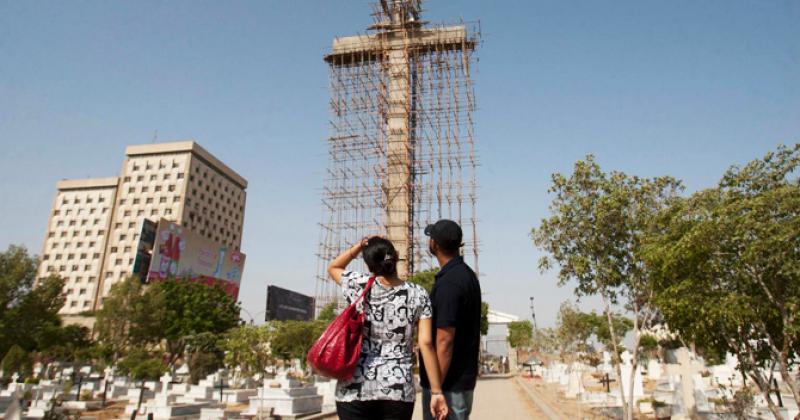A Christian businessman has built a monument in Karachi that has sparked a controversy first and foremost in the Church: is it a religious symbol or a show of power, destined to provoke Islamists?
It is going to be the biggest cross in Asia. A giant 43-metre-high cement cross has altered Karachi’s skyline. The port city in South Pakistan is the capital city of Sindh province.
With 23 million inhabitants, Karachi is a melting pot of ethnic and religious groups which receives large influxes of migrants. The Urdu-speaking Muslim majority lives alongside minority groups such as Sindhs, Balochs, Punjabis, Pashtuns, Gujaratis, Kashmiris and over a million Afghan refugees. Then there are hundreds of thousands of Bengalis, Arabs, Iranians and Burmese Muslim refugees.
In Karachi society where there are opposing forces at play, violence reigns and criminal groups compete over the management of illegal trafficking operations. In previous years the Catholic Church raised the alarm, calling for peaceful co-existence in the region.
In its innate and messy pluralism, Karachi is a place where religious communities enjoy freedoms that are difficult to find elsewhere in the country. The idea Christian businessman Parvez Henry Gill from Karachi had, testifies this. Gill, who said he acted on inspiration received from God, decided to pay for a 43-metre cross to be erected in the Christian cemetery in the centre of the city. The enormous cement tower, which “can even withstand gunfire”, will “show that Christians have religious freedom,” he explained.
The structure, which is almost complete, has sparked debate first and foremost within the Christian community. Catholics say the initiative “is more about gaining visibility than a real gesture of faith”.
Mario Rodrigues, a Catholic priest in Karachi, who was director of the Pontifical Missionary Works in Pakistan, did not hesitate to express his opposition to the cross, in a statement to Vatican Insider: “What need was there to erect that cross? Christians in Pakistan have a strong and deeply rooted faith. We have magnificent, majestic churches. A monument of this kind can be interpreted as an attempt to dominate and instigate a reaction from radical Islamist groups.”
Reactions, however, showed the complete opposite. According to some Muslims, the cross “proves that minorities enjoy complete freedom in Pakistan”. Others see it as a “frenzied omnipotence” instead of as an expression of pure religious sentiment.
“Karachi is a city without peace. Terrorist groups are running rampant. The government appears powerless and is unable to stop the violence,” says the diocese’s Justice and peace Commission.
Figures present Karachi as the most violent city in Pakistan. Around ten people are violently killed in the city each day: 2.500 victims were registered in 2012, a figure which rose to 3.200 in 2013 and 2.900 in 2014. In the first six months of 2015, 400 deaths were registered, 42 were killed in last May’s massacre when terrorists opened fire on a busload of faithful who belonged to the Ismaili Shia sect.
There are clashes taking place between political parties and their terrorist wings, in a bloody war that does not spare religious minorities. The red alert came when confirmation arrived that Taleban factions have started to actively operate in the city. Notably, Essa Nagri, an entirely Christian neighbourhood-ghetto inhabited by 50.000 faithful was targeted.
Karachi is home to some of Pakistan’s most beautiful and ancient churches, Catholics note. The neo-Gothic-style Catholic Cathedral of St. Patrick, is a testament to the greatness of the British Raj during the cathedral’s golden age. Founded in 1878, the church serves one of the oldest parishes in the country.
St. Andrew’s Church is another remarkable structure. Built by the Scots in 1868, with its 41-metre bell tower, it is a symbol of the ties between the Sindh province and Scotland. St. Lawrence’s Church, with its characteristic pink hue and Mughal-style architecture, is just as magnificent. In 1981 it celebrated its jubilee and the commemorative plaque was blessed by john Paul II during his visit to Pakistan that year.
Many Muslims remember that Muhammad Ali Jinnah, the founding father of Pakistan, joined the Christian community for a special celebration marking the country’s independence on 14 August 1947. The celebration took place in the Anglican Holy Trinity Cathedral, the oldest church in Pakistan, erected in 1849 and known as the “church of healing”.
“The cross is a symbol of God, only,” Gill stressed. But the size of the symbol influences the message and the erection of the cross in Karachi cemetery could be counterproductive for interreligious harmony.
